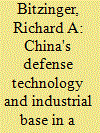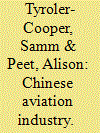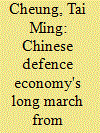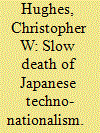| Srl | Item |
| 1 |
ID:
105078


|
|
|
|
|
| Publication |
2011.
|
| Summary/Abstract |
This article views China's development of anti-access capabilities against the backdrop of the theory and history of military innovation. It begins with a discussion of the process of military innovation, as well as the indicators that may appear at different stages of that process. It then discusses the barriers to recognizing new ways of war and applies that framework to China's development of advanced ballistic missiles, to include precision-guided conventional ballistic missiles and anti-ship ballistic missiles (ASBMs). It concludes with several suggestions for how to improve the ability to recognize and understand foreign military innovation.
|
|
|
|
|
|
|
|
|
|
|
|
|
|
|
|
| 2 |
ID:
105083


|
|
|
|
|
| Publication |
2011.
|
| Summary/Abstract |
This paper examines defense industrialization in three leading arms-producing states in Asia - India, Japan, and South Korea - and how their experiences compare to China's recent defense industrial developments. It argues that despite decades of considerable effort and investments in pursuit of a techno-nationalist self-arming strategy, these countries have experienced only modest success when it comes to achieving such self-reliance. Most regional defense industrial bases lack the necessary design skills and technological expertise in order to truly innovate, and at best these countries act as 'late innovators' when it comes to armaments production.
The experiences of these countries have lessons for China as it attempts to move into the first tier of arms-producing states. China has over the past 15 years made significant progress in modernizing its defense technological and industrial base. At the same time, China faces the same long-term challenges that currently confront other regional arms industries - that is, making techno-nationalism work at the later stages of innovation. This is particularly critical as China's defense industry strives to move from a basically platform-centric to an increasingly network-centric technological-industrial process.
|
|
|
|
|
|
|
|
|
|
|
|
|
|
|
|
| 3 |
ID:
105081


|
|
|
|
|
| Publication |
2011.
|
| Summary/Abstract |
The C919 program is representative of China's broader approach to advancing its aviation industry: dependence on foreign partnerships alongside investment in indigenous development. We find that this approach most closely fits the techno-hybrid model of technological development. This combination of techno-globalism and techno-nationalism is also found in the Aviation Industry Corporation of China's (AVIC) concept of indigenous innovation, macro strategy and structure, the controversy surrounding the recently revealed J-20 stealth fighter, and Chinese views of the potential for civil-military integration to aid in the development of a military airlifter. Truly indigenous development remains aspirational at this time, and the technological barriers that have caused China to depend upon international suppliers for the C919 project are also expected to inhibit domestic innovation and limit its impact on global aviation markets.
|
|
|
|
|
|
|
|
|
|
|
|
|
|
|
|
| 4 |
ID:
105079


|
|
|
|
|
| Publication |
2011.
|
| Summary/Abstract |
China's defense economy has been vigorously developing a comprehensive set of innovation capabilities that will eventually allow it to join the world's top tier of military technological powers. China's target is to catch up by 2020. Although this maybe possible in a few select areas, the defense economy as a whole will likely require another decade or more to successfully master the ability to produce major innovations of a radical nature. This paper analyzes the key areas in the Chinese defense economy's gradual but accelerating shift from imitation to indigenous innovation.
|
|
|
|
|
|
|
|
|
|
|
|
|
|
|
|
| 5 |
ID:
105084


|
|
|
|
|
| Publication |
2011.
|
| Summary/Abstract |
Japan's defense production model is often portrayed as an exemplar of techno-nationalism, but can it serve as a model for China to follow in pursuit of technological military catch-up? Japan in the past has exploited civilian industrial strengths to create a defense production base with footholds in key technologies. However, Japan's defense production model is now displaying structural limits - constrained defense budgets, deficient procurement management, limited international collaboration - with the risks of civilian industry exiting the sector, the loss of even basic competency in military technologies, and the consequent weakening of national security autonomy. Japan's case thus offers emerging comparative lessons for China to study in what to do and not to in pursuing civilian-military integration.
|
|
|
|
|
|
|
|
|
|
|
|
|
|
|
|
| 6 |
ID:
105080


|
|
|
|
|
| Publication |
2011.
|
| Summary/Abstract |
Does 'doctrine drive technology' or does 'technology drive doctrine'? For the United States with its advanced industrial and technological base, many examples of 'doctrine driving technology' can be found. For the People's Liberation Army (PLA), however, most evidence from military sources indicates that 'technology drives doctrine' or, as the Chinese say, 'technology determines tactics' (but not necessarily strategy). Within an overarching Chinese strategic framework, tactics and doctrine will be developed appropriate for (a) the weapons and technologies that are actually in the Chinese armed forces and (b) the people who must operate and maintain them. The Chinese civilian and military leadership has designated 2049 for completion of the modernization of the Chinese armed forces, a date selected in conjunction with the target for achieving China's main strategic priority, national economic modernization. Barring a major change in the strategic or domestic environment, we can expect that Beijing will continue to pursue the development of new weapons and technology in a manner consistent with the larger goal of national economic development. Exactly how China fights in the future will be dependent upon the weapons and technologies available - and they will be employed within the parameters defined by active defense and People's War.
|
|
|
|
|
|
|
|
|
|
|
|
|
|
|
|
| 7 |
ID:
105082


|
|
|
|
|
| Publication |
2011.
|
| Summary/Abstract |
China's space industry has made remarkable technological advances in the variety and sophistication of its satellites, human space flight program, and lunar exploration program. China appears to be taking an integrative innovation approach in which foreign technologies are built upon and improved rather than adopted wholesale. China's space industry is also undergoing major organizational change in which it plans to enter the commercial space sector and leverage its expertise in space technology to manufacture civilian products. This two-pronged strategy is designed to make China into a strong space power on par with the United States, Russia, and Europe. However, the space industry risks overreach and losing focus as it takes on multiple large projects.
|
|
|
|
|
|
|
|
|
|
|
|
|
|
|
|